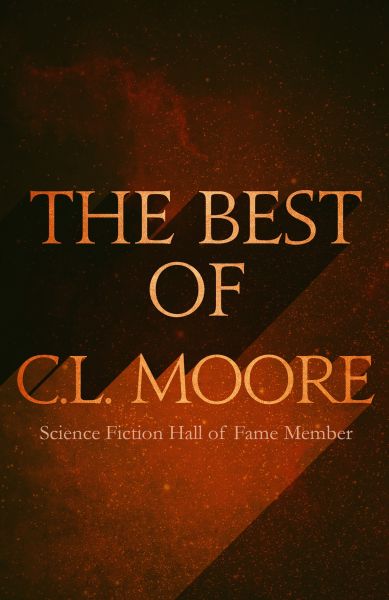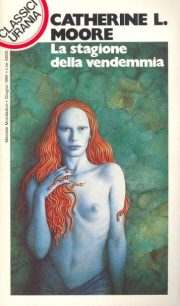Unexpected Rediscovery Review!
The Best of C.L. Moore
By C L Moore

6 Oct, 2015
0 comments
As previously mentioned, I am very fond of Ballantine’s Classic Library of Science Fiction. That said, editor Lester del Rey did have one blind spot in common with many of his contemporaries. You won’t find many women in Ballantine’s Classic Library of Science Fiction.

I note just two: Leigh Brackett, reviewed here fairly frequently, and Catherine Lucille Moore, the author of this week’s Rediscovery. Diversion has republished Moore’s 1975 collection, The Best of C. L. Moore, as an ebook. More relevantly to this review, they sent me a copy.
Moore was prolific and well-regarded. She would have been the second woman to be named Grandmaster of the Science Fiction Writers of America, had her second husband not intervened. He claimed that the honour would only confuse her (Moore had Alzheimer’s). But her work has nonetheless been acknowledged in other ways … by collections like this one, for example.
Note: this edition is not quite identical with the 1975 edition; the new ebook omits Lester del Rey’s introductory essay, 40 Years of C. L. Moore.
Shambleau • [Northwest Smith] • (1933) • novelette:
Is there any thing more outrageous than a mob attacking a helpless woman? Not to Northwest Smith, who never stops to ask exactly what the epithet “Shambleau” being hurled at the victim means. No worries, because he’ll find out first hand.
Comments:
When I read all of the Northwest Smith stories, I could not help but notice how often Northwest himself needs rescuing, often at the cost of the life of the woman he is supposedly helping. He could be deemed the masculine version of the Damsel in Distress.
This is a very early Moore. Her inexperience shows in the clunkiness of some of the prose, as well as in the pacing. The story barely pauses for the climax. Still, the story is solid enough that any given Moore collection (that does not exclude the Northwest Smith stories) will likely include it.
Black Thirst • [Northwest Smith] • (1934) • novelette:
Hired by a woman clearly unfamiliar with Smith’s track record where rescuing women is concerned, Smith discovers the dreadful secret behind the Alendar’s human breeding program. It has been raising women of unparalleled beauty for centuries … for a shocking reason.
Comments:
One of the fates worse than death is being rescued by Northwest. And by “rescued,” I mean “saving Northwest’s life at the cost of one’s own.”
Even though I reread this story recently, I thought it proper to read it again. My reward was spotting this interesting passage:
She has courage, this girl. She has intelligence. Where she got it I do not understand. I do not breed my girls for such things.
Hrm. Someone has issues.
This story shows a downside of so handsome even men desire him. The Alendar generally likes beautiful women, but will add Northwest to the menu if he’s available.
“The Bright Illusion” • (1934) • short story:
Dixon is forced to serve a dark god’s ambitions, in a realm so alien as to drive humans mad. He discovers that true love can transcend species, appearance, and even life itself.
Comments:
I wasn’t sure where Moore was going with this, but passionate Lovecraftian romance wasn’t anywhere on my list of possibilities.
Black God’s Kiss • [Jirel of Joiry] • (1934) • novelette:
An invader conquers Jirel’s castle and forces her to submit to an unwanted kiss. Jirel braves hell itself to seek a suitable punishment for the ruffian.
Comments:
Previously reviewed. Jirel is not at all a damsel in distress: cross her and she will cut you down. She met Northwest once. It was hilarious.
Tryst in Time • (1936) • novelette:
Adventurer Eric Rosner, bored with the 20th century, casts himself into the river of time itself. As he jumps from era to era, the one constant is a mysterious woman, a woman he realizes he must win! But death follows death and it seems as if they will never be together for more than a few hours at a time.
Comments:
Another true romance that ends, somewhat sentimentally, in death. Moore wouldn’t marry Kuttner for another four years (1); I wonder what her models for romance were?
Greater Than Gods • (1939) • novelette:
Researcher Bill Cory learns that the fate of his race depends on which of two alluring women he weds. He can marry Sally and consign the race to a Utopian but stagnant matriarchy. Or he can marry Marta, and ensure a regimented fascism that will reach out to the stars.
Comments:
Even in 1936, one might expect statements like
Women as a sex are not scientists, not inventors, not mechanics or engineers or architects
to be garnished with qualifiers like “most”. But this story would fall apart if certain talents did not vanish in the absence of masculine domination.
Given the two choices (Sally’s nicey-nice world and Marta’s boot stamping on the face of humanity forever world), it’s hard to see the decision as requiring more than a moment’s thought. I guess things looked different in 1936.
Fruit of Knowledge • (1940) • novelette:
A retelling of the expulsion from the Garden of Eden , this time from Lilith’s point of view. You all know who Lilith is, right?
Comments:
Eve is written as a bit of a drip. But then, none of the characters in this story come off as all that appealing.
I don’t think I’ve even seen Lucifer’s fall presented as something that’s both important and also very much off stage. It basically plays the same role for on-stage events in this story as the Fall of France does for Casablanca.
No Woman Born • (1944) • novelette:
Maltzer is a genius who has used cutting-edge technology to transform a badly burned victim from a basket case to a glittering example of all science can accomplish. He fears that Deirdre’s fragile feminine mind will not be able to cope with this reversal of fortune. His assumption is … somewhat short of being entirely correct.
Comments:
I wonder if Deirdre and the guy from Arthur C. Clarke’s A Meeting with Medusa ever compared notes.
“Daemon” • (1946) • short story:
Luiz o Bobo, Luiz the Simple, insists that he has no soul. This deficiency may explain how it is that Luiz can see shades and gods invisible to the ensouled — but it doesn’t explain how the poor man ended up dying on a deserted island. That’s entirely thanks to human vice as embodied in a former employer.
Comments:
I hope Luiz isn’t supposed to be soulless because he’s simple-minded.
Vintage Season • (1946) • novella:
It doesn’t matter whether they came to town to drink beer while wearing cheap green felt hats or whether they just want to watch the end of the world. Tourists suck
Comments:
(Some sources give Moore’s husband and frequent collaborator Henry Kuttner some credit for this piece, but the consensus is that Moore did somewhere between most and all of the heavy lifting for this story.)
The Sci-Fi Radio version of this classic makes it very clear that Kleph isn’t just a manic pixie dream girl, but a pothead manic pixie dream girl. And the dream is really more of a nightmare from which the protagonist isn’t going to wake up.
There was a movie adaptation (of sorts) in 1992. [link ]. I have not seen this, but the synopsis and reviews hint that the producers carefully removed the very elements that make the novelette a classic.
“Afterword: Footnote to ‘Shambleau’… and Others” • (1975) • essay:
This is the only essay by Moore that I am aware of having read. She comments on various stories from the collection, in the course of which she corrects a common misapprehension about the writing of “Shambleau,” or rather, its publication:
One last comment on “Shambleau.” This is as good a time as any to clear up a misconception which has long crept about unchallenged. This story was not rejected by every magazine in the field before it crept humbly to the doorstep of Weird Tales. My own perfectly clear memory tells me that I sent it first to WT because that was the only magazine of the type I knew well, and that an answering acceptance and a check for the (then) fabulous amount of $100.00 arrived almost by return mail.
Actually, I was far too unsure of myself to have hammered on the door of every publisher in New York if my first opus had been so unkindly treated. I’d simply have given it up and turned to some other form of activity, and this book would not be in your hands now. (I’m glad it is, too.)
General comments
I was afraid that a rereading would sully my pleasant memory of the collection, but I am glad to report that it stands up to a later, older regard. My thanks to Diversion for making the collection easily available for the first time in thirty-four years (in an English-language edition, I mean; it has been translated and republished in other languages).
I’ve used the Diversion cover in my introduction. While this collection didn’t go through all that many editions, it has had more than its fair share of covers. The cover with which I am most familiar is the Brothers Hildebrand cover.

Well, it’s functional, depicts a scene from one of the stories, and is not entirely off-putting … which makes it a good cover for the 1970s, in which none of those qualities were guaranteed.
The original hardcover cover art by Chet Jezierski

gives me the impression that Northwest has just realized that he should have asked Yarol to phone him, in case he needed an excuse to bug out on a blind date that has gone badly. Which it seems to have done. The illustration begs for a fitting caption. Suggestions invited in comments
The Arnoldo Mondadori Editore edition features art from Oscar Chichoni.

He has a fine sense of the disturbing, although not the erotic.
The Taplinger edition has rather unmemorable Rus Anderson art.

I prefer a creepy bad girl, or a blind date gone hilariously wrong, to bland and forgettable.
I don’t know who did the cover art for the current edition. but I heartily approve of the inclusion of the phrase “Science Fiction Hall of Fame Member.” Moore was part of the 1998 (third) cohort of Hall of Famers, the second woman (after Andre Norton) to be so honoured. If I have counted correctly, she is one of just thirteen women in the eight-four Hall of Famers.
The Best of C. L. Moore is available from Diversion. Amazon seems to be offering it for free at the time I am writing.
1: Moore and Kuttner married in 1940, which means all of these pieces but “Daemon” and “Vintage Season” predate their marriage. This is probably not coincidental, because the couple’s collaboration habits made it hard to tell who wrote what. Being absolutely certain a particular story was all Moore or all Kuttner gets challenging after 1940 (and it’s my impression that, because the Kuttner byline was paid better than the Moore (or Moore and Kuttner) bylines, a lot of collaborative material was sold as Kuttner solo work).
Centipede used the obvious solution in their exemplary 2005 collection, Two-Handed Engine: The Selected Stories of Henry Kuttner and C. L. Moore, which I would recommend enthusiastically if it wasn’t A) $225.00 and B) out of print. There was a much more affordable SFBC edition but I believe it too is out of print.
I just realized that interlibrary loan is totally a thing and that it may enable a future review of Two-Handed Engine.
Except KPL updated their site and in the process broke the ILL link. Bother.
[update]
This works. Excellent.
